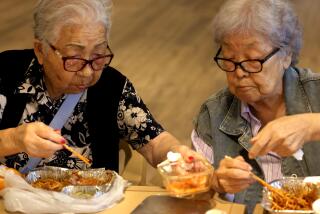Recipe for Retirees
CAMARILLO — Pat Stewart says she doesn’t like to cook. But according to Max Grant, her lunch companion on a recent Friday, it’s that she doesn’t like to wash the dishes afterward.
Whichever, Stewart--who won’t reveal her age except to say that she won’t see 80 again--is served her lunches daily at the Camarillo Parks and Recreation Community Center.
“I’ve been coming here for 10 years, five days a week, unless I’m sick or out of town,” said Stewart, who helped set up a similar senior nutrition site in the Inyo County town of Bishop with her husband, who died in 1980.
“This is one place we can come and eat with our elbows on the table,” said the 77-year-old Grant, a retired newspaper distributor who’s been eating lunch at the community center for five years.
Stewart and Grant are two of the senior citizens who take advantage of the county’s Senior Nutrition Program, which has been serving seniors lunches for 22 years.
The Camarillo-based program daily serves about 500 county residents, age 60 and older, at 17 dining centers from Simi Valley to Ventura, and sends another 500 lunches to the home-bound through the Meals on Wheels program.
*
In between bites of seafood salad last week at the Camarillo community center, Richard Dvorak praised the quality of the food. Entrees, which change daily, range from Oriental chicken, salmon fillet or roast beef to vegetable omelets, macaroni and cheese or stuffed green peppers.
The price of a meal is also quite a deal.
Although it costs program administrators $3.50 to produce each meal, they only ask for a $2.25 donation from those who dine at the centers and for a $2.75 donation from those who have the meals delivered to their doors.
Nagi Kiser, 73, who’s been frequenting the center since she retired as head librarian at Camarillo State Hospital in 1993, said it’s important to note that the Senior Nutrition Program is for everyone.
“It’s not just for the poor,” she said. “We have all kinds coming here, even a doctor.”
There is, however, a stigma that the program is for low-income people, said program director Violet Henry.
“We do target low-income seniors . . . but it’s for everyone,” she said.
Financial status does not matter. Nor does it matter if the appetite is large or small. Program volunteers will pack leftovers for the diners or distribute sack lunches to those with heftier appetites.
Although a higher percentage of seniors live in Camarillo than in any other city in the county, a disproportionately low number actually make it out to the dining centers.
The program serves about 20 seniors a day at Club Camarillo, an adult day-care center, and 30 to 40 at the community center.
“To tell you the truth, we should have triple the amount of people here than we do because of all the seniors in Camarillo,” said Dvorak, who turned 85 last Saturday and has been coming to the center every day since he lost his third wife four years ago.
Henry said she plans to meet with the Camarillo Health District and the Parks and Recreation Department later this month to design an outreach program that will target Camarillo seniors.
*
The program does, however, serve more home-delivered meals in Camarillo than anywhere else in the county--a total of 75 to 80 meals per day.
“Without the [Meals on Wheels] service, most of the people would end up in nursing homes, because sometimes this meal is the one thing that allows them to stay home,” said Henry, who has been the program’s director for 14 years.
The Senior Nutrition Program does more than fill empty stomachs, organizers say--it also prevents people from being isolated.
“The purpose of the program is to keep people active, to give them a place to socialize and something to do,” Henry said. “A lot of the people who come here are recently widowed or retired.”
The health of seniors may become jeopardized if they are widowed or depressed and they lose their appetite, Henry said. “So we try to get them out to the dining centers for meals or to volunteer.”
Isolation is indeed a serious problem, according to Linda Sharp, Club Camarillo’s coordinator.
“So many seniors do become socially isolated and their world becomes very small,” Sharp said. “It is not uncommon for people to go through a day, a week or many days and not have contact with people.
“Usually boredom will set in and that boredom turns into depression,” she said. “Then they end up sleeping most of the day and in front of the television set when they are awake.”
*
Any time seniors become more socially active, it has positive effects, Sharp said, adding that the Senior Nutrition Program makes it easier for seniors to get out by providing a transportation service.
The program, which costs about $1.3 million a year to operate, is funded through a federal grant, fund-raisers and donations.
(BEGIN TEXT OF INFOBOX / INFOGRAPHIC)
FYI
Lunch is served at noon Monday through Friday at 17 dining facilities throughout the county. Call 388-4317 for a list of centers or for information about free transportation to the dining facilities, Meals on Wheels or the volunteer program.
More to Read
Eat your way across L.A.
Get our weekly Tasting Notes newsletter for reviews, news and more.
You may occasionally receive promotional content from the Los Angeles Times.










